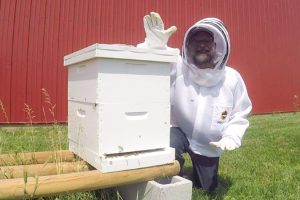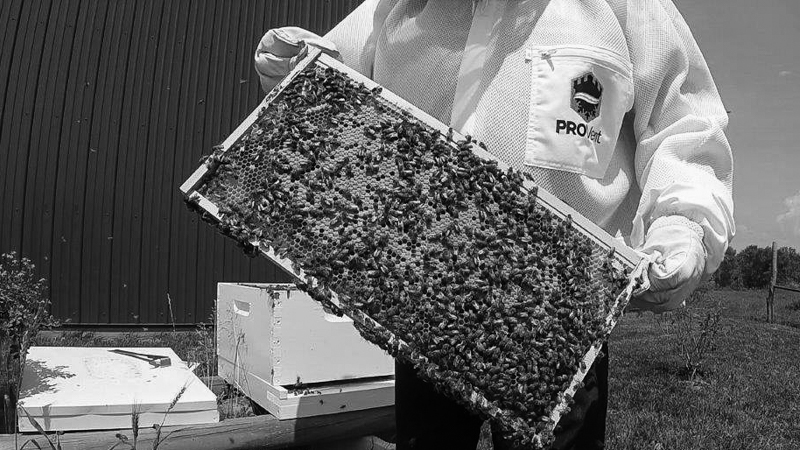Beekeeping is a hobby that fits me well. It involves a mix of challenges, learning, and enjoyment. I attended a Knox County Beekeepers Association class yesterday. Here are some interesting things I learned at that class, other classes, and though my work in the hives this past year.
- The queen bee is queen! The hive dies with no queen. She determines the number of bees in the hive, as well as, their sex and role in life.
- The average worker bee lives six to seven weeks while the bee that overwinters in the hive lives four to six months.
- Bees pollinate fruit, vegetables, flowers, plants, and even weeds as they gather nectar and pollen from the blooms. Our grocery trip would be dismal without bees.
- Beekeeping is a learning experience that is quite rewarding. I learn something every time I open the hive.
- Bees share their food. Honey is the food that keeps the hive alive during the lean times. A good beekeeper knows how much honey to leave them for winter and lean times.
- Beekeeping is a money pit. Expect to invest $400 in your first hive. A package of bee’s costs $125. Add the cost of tools and accessories. That’s why honey costs what it does in the market.
- Bees have sex for 2 seconds and the drone (male) dies as his internals are ripped from the body as the queen flies away.
- The queen has a once-in-her-life sex-filled flight where she engages in the act with about fifteen drones.
- The queen stores seven million sperm from her orgy flight and fertilizes 1,000 eggs a day during her lifetime.
- A virgin queen can lay eggs. They will be fertile but emerge as drones.
- Bees are communal with distinct roles. Some bees guard the hive. Others nurse young bees. There are house cleaners and comb builders. They work together for survival.
- Let a bee alone. The bee lets you alone. Honey bees are peaceful. They don’t mind you stopping by to watch them fly in and out of the hive.
- Don’t swat the bee. Bees release a pheromone when they are threatened. Kill one bee. It tells the others to come and protect the hive.
 Girls rule. The queen is in charge. Worker bees and the bees you see collecting nectar and pollen are females. Males serve one purpose in life, to sacrifice themselves in sex.
Girls rule. The queen is in charge. Worker bees and the bees you see collecting nectar and pollen are females. Males serve one purpose in life, to sacrifice themselves in sex.- Bees are smart and adaptive. A hive sizes itself appropriate to the season. A hive can have as many as 60,000 bees at the height of summer and as few as 10,000 bees during winter.
- Varroa mites are the biggest danger American hives face today. These parasites attach themselves to the backs of the bees and grow exponentially in weeks leading to the death of a hive.
- Varroa mites prefer to lay eggs on drone cells. Drones are larger and take longer to emerge giving mites more time to mature. Mites are 8-12 times more likely to choose a drone host.
- Sting and die. A bee sacrifices her life when she stings you. The barbs on the stinger embeds in your skin. She pulls out her internals as she attempts to fly away.
- Speaking of stings, male bees do not have stingers.
- Bees can hold their waste for months. The bee’s abdomen allows their intestines to expand and store waste. On warm winter days, bees leave the hive on cleansing flights to rid themselves of waste.
- Bee are morning people. The beehive comes alive when the hot morning sun hits it. They fly out for nectar, pollen and water. Bees do their work in the warmth of the day.
- A new hive seldom leaves honey for the beekeeper. Bees spend their first-year building comb and honey stores in the hive. Beekeepers must leave ample honey for survival in the winter.
- Beehives are heavy. Those white boxes can weigh as much as 90 pounds when full of honey.
- Beekeeping is hands-on. Beehives need to be opened at least twice a month in warm weather months to see what is happening. The beekeeper must proactively treat pest and parasites, feed when needed, and prevent the hive from swarming.
- Bees swarm when the hive is running out of space. The queen takes half of the bees with her to find a new roomier home.
- Bees produce supercedure cells of queens in waiting. When a swarm leaves, the first queen to emerge in the original hive becomes queen and the other emerging queens are killed. Brutal!
Save the bees.
Tom Bilcze
(Visited 109 times, 1 visits today)

